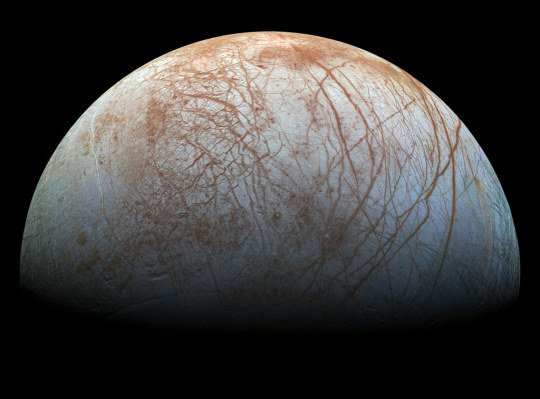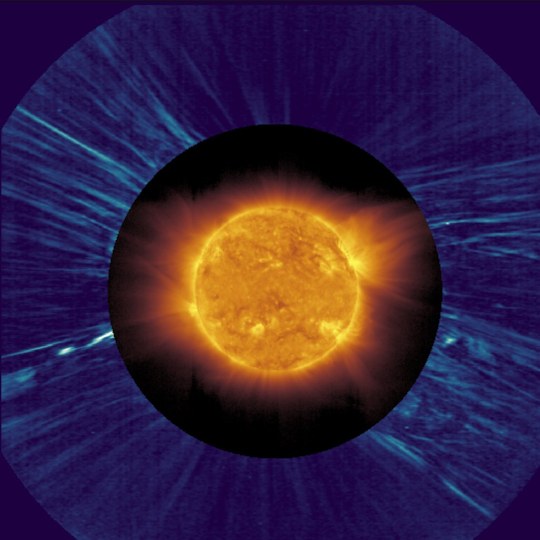#spacetechno
Photo

Corona details by europeanspaceagency https://flic.kr/p/2gqP8fB
515 notes
·
View notes
Photo

New evidence of watery plumes on Jupiter’s moon Europa de europeanspaceagency https://flic.kr/p/2j1mm4r
2 notes
·
View notes
Photo

Cloud-free Iceland by europeanspaceagency As we eagerly await the return of our Earth from Space programme next Friday, today the Copernicus Sentinel-3 mission shows us a rare, cloud-free view of Iceland captured on 14 August 2020. The large, white area visible on the island is a national park that encompasses the Vatnajökull Glacier. Covering an area of around 8400 sq km with an average ice thickness of more than 900 m, Vatnajökull is not only classified as the biggest glacier in Iceland, but the biggest in Europe. The white, circular patch in the centre of the country is Hofsjökull, the country’s third largest glacier and its largest active volcano. The elongated white area west of Hofsjökull is Langjökull, Iceland’s second largest ice cap. Reykjavík, the capital and largest city of Iceland, is located on the Seltjarnarnes Peninsula, in southwest Iceland. In the top-left of the image, several sea ice swirls can be seen off the coast of Greenland. Sentinel-3 is a two-satellite mission to supply the coverage and data delivery needed for Europe’s Copernicus environmental monitoring programme. Each satellite’s instrument package includes an optical sensor to monitor changes in the colour of Earth’s surfaces. Credits: contains modified Copernicus Sentinel data (2020), processed by ESA, CC BY-SA 3.0 IGO https://flic.kr/p/2jASPA1
0 notes
Photo

Good (#spacetechno) Evening II ⭐ #LukeSlater - 'When It Twists' from 'Air Texture VII' by #Rrose + #SilentServant http://airtexture.bandcamp.com/track/luke-slater-when-it-twists (på/i Hake Cape Hill) https://www.instagram.com/p/B9H4cATJXMh/?igshid=1v9ztdisq98lv
0 notes
Link
Reptillus Club Kid On GHB LSD25 KHOLE by DJ Bejay Rose on #SoundCloud
#i love techno#technofit#technoforlife#technofashion#club techno#techno clubkid dj#edm life#edmfamily#edm blog#edmgirls#edmboys#edmbeat#spacetechno#spacemusic
1 note
·
View note
Photo

ASC - Realm of the Infinite | It’s been a great year for fast techno, and a stellar one for ASC specifically - great ambient on @silentseason, dark breakbeat on @samurai_music, and now this instant classic on @auxiliarymusic. Super clean and loud pressing, especially for clear vinyl! . . . . . #ASC #RealmOfTheInfinite #Auxiliary #techno #fasttechno #space #spacetechno #bassy #vinyl #LP #record https://www.instagram.com/p/B0B6wXYBd0x/?igshid=eptdotozxtta
0 notes
Audio
(dr animale)
2 notes
·
View notes
Photo

Topography of Ascraeus Mons by europeanspaceagency https://flic.kr/p/2ozjtKn
19 notes
·
View notes
Photo

Capturing a solar switchback by europeanspaceagency The Sun as seen by the ESA/NASA Solar Orbiter spacecraft on 25 March 2022, one day before its closest approach of about 0.32 au, which brought it inside the orbit of planet Mercury. The central image was taken by the Extreme Ultraviolet Imager (EUI) instrument. The outer image was taken by the coronagraph Metis, an instrument that blocks out the bright light of the Sun’s surface in order to see the Sun’s faint outer atmosphere, known as the corona. The Metis image has been processed to bring out structures in the corona. This revealed the switchback (the prominent white/light blue feature at the roughly 8 o’clock position in the lower left). It appears to trace back to the active region on the surface of the Sun, where loops of magnetism have broken through the Sun’s surface. See infographic for labeled features. Read more Credits:ESA & NASA/Solar Orbiter/EUI & Metis Teams and D. Telloni et al. (2022) https://flic.kr/p/2nM1Gn7
40 notes
·
View notes
Photo

Europe by europeanspaceagency https://flic.kr/p/2oxWxU5
7 notes
·
View notes
Photo

Melt ponds in West Greenland by europeanspaceagency During spring and summer, as the air warms up and the sun beats down on the Greenland Ice Sheet, melt ponds pop up. Melt ponds are vast pools of open water that form on both sea ice and ice sheets and are visible as turquoise-blue pools of water in this Copernicus Sentinel-2 image. When snow and ice melts atop glaciers, water flows in channels and streams and collects in depressions on the surface. These melt ponds can speed up the melting of the surrounding ice since they greatly reduce the ice’s ability to reflect sunlight. This can create a positive feedback where an increasing number of melt ponds absorb more heat which causes ice cover to melt even faster. In this image, captured on 29 August 2022, melt ponds in the province of Avannaata can be easily spotted from space as they are usually much darker than the surrounding ice. In some ponds, chunks of ice float atop the pond’s waters. The bay visible here is Sugar Loaf Bay (an indentation of the northeast Baffin Bay) in the Upernavik Archipelago. The archipelago extends from the northwest coast of Sigguup Nunaa peninsula to the southern end of Melville Bay. The Greenland Ice Sheet is the largest ice mass in the northern hemisphere. It extends 2220 km north-south with an average thickness of around 1500 m and spans 1100 km at its widest point. As most of the northern hemisphere baked under a prolonged heatwave this summer, Greenland has been hit with an unusual late-season heatwave and melt event in early September – the kind of melt that usually occurs in the middle of summer. The first day of September typically marks the end of the Greenland melt season, as the sun moves lower in the sky with temperatures usually cooling. However, at the beginning of September 2022, temperatures began to rise again when a strong air pressure region parked at the southeast edge of Greenland and drew warmer air northwards across Baffin Bay and the west coast of Greenland. This led to meltwater runoff, the amount of surface water entering the ocean, to increase with its extensive melting contributing to global sea level rise – which impacts the millions of people living in coastal communities. In a recent paper published in Nature Climate Change, scientists found that major sea-level rise from the melting of the Greenland ice cap is now ‘inevitable’ even if the burning of fossil fuels were to halt overnight. Using satellite observations of Greenland ice loss and ice cap from 2000 to 2019, the team found the losses will lead to a minimum rise of 27 cm regardless of climate change. Earth observation satellites are key to monitoring ice as they carry instruments that measure changes in the thickness of the ice sheets, fluctuations in the speed of the outlet glaciers and even small changes in Earth’s gravity field caused by melting ice as well as sea-level rise. This image is also featured on the Earth from Space video programme. Credits: contains modified Copernicus Sentinel data (2022), processed by ESA, CC BY-SA 3.0 IGO https://flic.kr/p/2nPS5th
32 notes
·
View notes